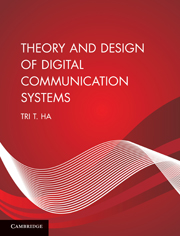Book contents
- Frontmatter
- Contents
- Preface
- Acknowledgements
- List of symbols
- List of abbreviations
- 1 Introduction
- 2 Deterministic signal analysis
- 3 Random signal analysis
- 4 Information theory and channel coding
- 5 Communication link analysis
- 6 Modulation
- 7 Demodulation
- 8 Spread spectrum
- 9 Intersymbol interference and equalization
- 10 Fading channels
- Index
- References
5 - Communication link analysis
Published online by Cambridge University Press: 05 June 2012
- Frontmatter
- Contents
- Preface
- Acknowledgements
- List of symbols
- List of abbreviations
- 1 Introduction
- 2 Deterministic signal analysis
- 3 Random signal analysis
- 4 Information theory and channel coding
- 5 Communication link analysis
- 6 Modulation
- 7 Demodulation
- 8 Spread spectrum
- 9 Intersymbol interference and equalization
- 10 Fading channels
- Index
- References
Summary
Introduction
In this chapter, we provide the foundation for analyzing a wireless communication link. The purpose is to evaluate the signal-to-noise ratio at the receiver to assess the link performance. Evaluation of the signal power and noise power requires the path loss and receiver system noise temperature, respectively. The receiver consists of an antenna, a low-noise amplifier, a downconverter, and a demodulator. The concept of the thermal noise source and its noise temperature, as well as the antenna noise temperature, is discussed. We also introduce the effective noise temperature and noise figure of a two-port network such as the low-noise amplifier, downconverter, or demodulator. The effective noise temperature and noise figure of a cascade or series connection of two-port networks are derived. This leads to the evaluation of the receiver system noise temperature.
For free space links, such as satellite communications links, we introduce the Friis equation to calculate the path loss. For cellular communications links, we present the well-known Hata model. Many important aspects of cellular systems are also discussed, such as the frequency spectrum, standards, and the co-channel interference.
Basic wireless communication link
In wireless communications, the point-to-point link is the simplest connection between a transmitter and a receiver. In this basic link, the transmitted signal travels the line-of-sight path to the receiver and the channel is the free space. A typical wireless communication system is shown in Figure 5.1.
- Type
- Chapter
- Information
- Theory and Design of Digital Communication Systems , pp. 177 - 224Publisher: Cambridge University PressPrint publication year: 2010



